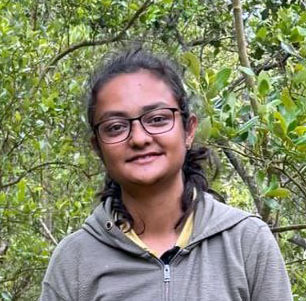The Coringa Wildlife Sanctuary (CWS) sits at the confluence of the Godavari River—the longest river in southern India—and the Bay of Bengal. Spanning 235 square kilometres on the western coast of Andhra Pradesh, it encompasses 40 percent of the state’s mangrove cover.
Established as a wildlife sanctuary in 1978, it offers an appropriate site in which to study ecological variables and understand systemic ecological responses to the changing climate, rising sea level, sediment dynamics and tidal and salinity fluctuations. As such, a group of local, national and international collaborators are currently working to establish long-term monitoring sites in the area.

A golden jackal (Canis aureus) in Coringa Wildlife Sanctuary. Photo by Samakshi Tiwari/CIFOR-ICRAF
The sanctuary protects mammals such as the fishing cat (Prionailurus viverrinus) and the golden jackal (Canis aureus), and is also a breeding site for the olive ridley turtle (Lepidochelys olivacea).
Over 245 bird species have been recorded in the sanctuary, including the threatened white-backed vulture (Gyps africanus) and long-billed vulture (Gyps indicus). A total of 382 fish species belonging to 98 families and 25 orders have also been documented in the East Godavari River Estuarine Ecosystem, of which Coringa forms an integral part.
The Sanctuary’s mangrove forests play important roles in sustaining the livelihoods of local communities, particularly through serving as nurseries that support fisheries. Overall, about 80,000 people from over 40 villages depend on resources originating from the sanctuary. It also attracts hundreds of tourists daily—often including school students on study trips—who make the most of the 2.3 km mangrove boardwalk and boating facilities to experience this unique ecosystem up close. The mangroves also provide other ecosystem services like protection from cyclones and floods, water and air purification and carbon sequestration.

The boardwalk through the Coringa Wildlife Sanctuary. Photo by Samakshi Tiwari/CIFOR-ICRAF
The CWS encompasses an interesting mosaic of natural and restored mangroves, as the Andhra Pradesh Forest Department has successfully restored various areas therein that had been converted to aquaculture ponds. However, like many other mangrove forests across the globe, Coringa’s ecosystems remain threatened by climate change and other anthropogenic pressures emerging in the area. The westernmost edge of Coringa extends northwards to Kakinada Port, which adjoins Kakinada Beach. This commercial centre and public use areas often contribute plastic and chemical pollution, undermining the overall ecological integrity of the sanctuary, while natural beaches and shoreline are also threatened by erosion and rising sea levels.
Meanwhile, the presence of cement and boat manufacturing units surrounding some of the tributaries that bring water to the Godavari contribute to pollution loads and threaten the ecological balance of the estuary. Exotic invasive Prosopis plants could also alter the environmental conditions essential for the growth of native species.
Each of these stressors, combined with changes in quantity and quality of water in the creeks draining the sanctuary, have a negative effect on the natural environment and its flora and fauna. The signs of mounting stress and imbalance are evident in certain parts of the sanctuary, as considerable degradation and mortality of mangroves has been reported—particularly on the eastern coast.

Ghost nets and plastic on the Coringa shore. Photo by Samakshi Tiwari/CIFOR-ICRAF
Despite their importance, mangrove forests across the globe are under threat from various impacts—such as pollution and increasing rates of sea level rise. There is a paucity of information on how these forests are responding to anthropogenic and natural stressors at short-term and long-term time horizons.
To address this knowledge gap, a new monitoring programme has been initiated to collect and analyze data on ecological indicators of mangrove health for extended periods to help managers make informed decisions and plan interventions as necessary. The Center for International Forestry Research and World Agroforestry (CIFOR-ICRAF)—alongside collaborators such as the US Forest Service (USFS), M S Swaminathan Research Foundation (MSSRF), National Centre for Coastal Research (NCCR) and the Andhra Pradesh Forest Department—has begun collecting in-situ data in the area. This effort is part of the Mangrove Monitoring for Climate Change Mitigation in India programme, under which studies on mangrove vegetation and forest structure, carbon stocks estimates of natural and restored mangroves, sedimentation rates and tidal and salinity fluctuations are being measured at selected sites.

rSET measurement at Coringa Wildlife Sanctuary. Photo by Rupesh Bhomia/CIFOR-ICRAF
The information is gathered by using Rod Surface Elevation Tables (rSETs), automated salinity and water depth sensors and following Sustainable Wetland Adaptation and Mitigation Program (SWAMP) protocol. These long-term monitoring sites were established across CWS in December of 2023. The data they collect will be helpful in developing improved management strategies to ensure greater resilience to the impacts of climate change.
The monitoring sites in CWS are a subset of 47 rSETs established across India’s east coast, from the Sundarbans to West Bengal and the Andaman Islands. Sites will also be established in Odisha’s Bhitarkanika National Park in the coming months. This information will assist local forest departments and researchers in developing site-specific strategies to prevent degradation of mangroves and help in restoration efforts. Since mangroves offer many ecosystem services and protect against cyclones and floods, the work will contribute towards developing coastal resilience throughout the region.
We want you to share Forests News content, which is licensed under Creative Commons Attribution-NonCommercial-ShareAlike 4.0 International (CC BY-NC-SA 4.0). This means you are free to redistribute our material for non-commercial purposes. All we ask is that you give Forests News appropriate credit and link to the original Forests News content, indicate if changes were made, and distribute your contributions under the same Creative Commons license. You must notify Forests News if you repost, reprint or reuse our materials by contacting forestsnews@cifor-icraf.org.












